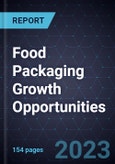Increasing Food & Beverage Consumption Drives Future Growth Potential in Developing Economies
Packaging is vital to the food and beverages (F&B) industry as it protects products from external contamination and environmental factors, such as temperature changes and humidity. Packaging also enhances the shelf life of food products while supplementing the logistics and storage operations. On the consumer end, packaging plays a critical role in product marketing. The right type of eye-catching packaging with optimum labeling can influence the customer’s buying decision. Overall, the food packaging market holds growth opportunities for raw material suppliers, converters/packaging manufacturers, recycling companies, and downstream food and beverage processors.
The global food packaging market is expected to grow in tandem with the F&B industry. As food consumption rises with an expanding population, shifting demographics, changing consumer lifestyles, and increasing disposable income, demand for food products and subsequently food packaging increases. The popularity of pre-cut, pre-portioned, smaller, and ready-to-consume food products reflects the importance of convenience for today’s consumers. Hence, the demand for packaging per food unit is set to increase. Focus on enhancing shelf life also boosts demand for food packaging.
Accounting for a significant proportion of the market, plastics are largely preferred in different F&B packaging applications. The lightweighting trend prevalent throughout the packaging industry is contributing to growth in the plastics segment. Further, plastics are one of the most cost-effective packaging materials and will retain dominance throughout the forecast period (2023 to 2029). Products such as flexible films, bottles, jars, and caps and closures are well-established in their respective applications and will witness steady growth throughout the forecast period. From an applications standpoint, packaging is used more so in food packaging than in beverages and pet food applications.
The food packaging market is highly fragmented, populated by both global players and several regional and local manufacturers that focus on specific product areas. Manufacturers fundamentally compete based on price and material quality. The significantly high population in areas of Asia-Pacific augments regional demand for food packaging. Further, developed regions such as North America and Europe are more focused on sustainability by implementing recycling targets and similar regulations. Hence, these regions will likely witness steady growth while rapidly replacing conventional packaging solutions with recycled/recyclable counterparts.
This study analyzes the status of and prospects for different types of F&B packaging products, including plastics; paper and paperboard; glass, metals and alloys; and multi-materials. It covers primary and secondary packaging because of their consumer focus but not tertiary packaging, which serves a logistical purpose. The research considers this market’s shipment volumes and revenue from 2019 to 2029 and records manufacturer-level revenues and prices.








